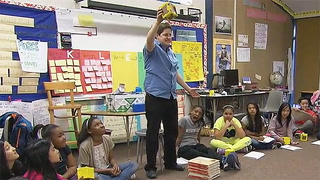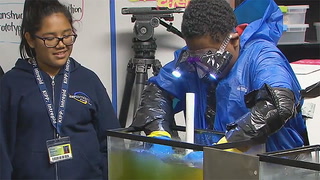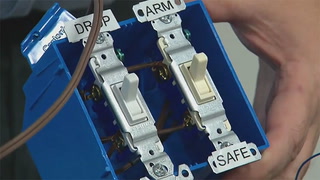CubeSats: Big Science in Small Packages Transcript
+++ 00:00:03 +++
Student: No pressure.
Student: I’m thinking we should make like an X right here, ‘cause Xs are strong.
Student: Okay, let’s do it again.
Lower Third:
Engineering Design in the Classroom: Cubesats – Big Science in Small Packages
+++ 00:00:21 +++
Marcia Ventura: Okay, so today is our third day of working with our cubesats and, what you’re going to get to do, you’re going to get together with your engineering partner, and you and your engineering partner will have about five minutes to just make any last minute changes that you might have. In today’s lesson we started out by
Lower Third:
Marcia Ventura
5th Grade Teacher,
Maple Elementary School, Seattle, WA
+++ 00:00:42 +++
Marcia Ventura: …by just having them work with the materials that they were working with yesterday. So we started out by just giving them those few more minutes to really get a handle on their models. What’s that?
Student: It don’t got to be pretty.
Marcia Ventura: It doesn't have to be pretty it just needs to work.
Student: All it need is, it just need to work.
+++ 00:00:57 +++
Marcia Ventura: Just needs to function, that’s right. So I was invited to become part of the Boeing project. The draw for me was that I’d get to work with engineers, to create a unit. We chose to work on these microsatellites called cubesats. Now I’m a little bit concerned about this part right here, that it’s not going to measure exactly ten centimeters. So, I wonder what you can do about that. The engineers and I developed a unit in which the kids would get going right away with building a model of a
+++ 00:01:30 +++
cube satellite, just basic cardboard, duct tape, a battery, a computer board that’s really just, you know, tag paper, and then after that concrete experience of making that, then delve into, you know, what do satellites do and how do they move in space and how do we use satellites here on earth, like what is the purpose behind them? I’m loving that I’m seeing a lot of people doing their testing already
+++ 00:02:00 +++
before our group test over here, so that’s really great, that’s showing me that you are shooting for a really, really strong design, that’s great.
+++ 00:02:09 +++
Kim Hicks: My name is Kim Hicks, I’m a systems engineer. I’m a pilot…
Lower Third:
Kim Hicks
System Integration & Design Engineer
The Boeing Company, Seattle, WA
Kim Hicks: …I’ve designed a, I’ve worked on aircraft design, spacecraft design.
Marcia Ventura: Guys this is.
Kim Hicks: Working with Marcia was great, she was exuberant and we hit it off right off the bat and we were able to come up with some, a place where we could meet in the middle of, you know, what’s real world and then what’s something that a fifth grader can understand.
+++ 00:02:30: +++
Marcia Ventura: I’m really excited to see how you guys, how your cubesats make it through this testing.
Kim Hicks: You know it’s also a great learning opportunity on our part because we were able to sit there and better articulate what that meant to do a particular type of testing.
+++ 00:02:45 +++
Marcia Ventura: Then we go through a cubesat four point test. Now, in the real world, space engineers, what they do when they test their cubesat, is they actually have it on something called a shaker table, and it shakes at a really super high rate, everybody go like this. Okay? Now, what do you think that’s trying to simulate?
Student: To see how strong it is.
Marcia Ventura: To see how strong it is, okay. Let’s move into a different direction here. So think about cubesats and how they might be getting up into space. We haven’t talked about this yet.
+++ 00:03:23 +++
Student: They probably put it on rocket ships, like when they go up to space and put like, you know like, yeah, and bring it up from there.
Marcia Ventura: I’m thinking the same thing.
Kim Hicks: This was a perfect platform to introduce the kids to critical thinking exercises where you’re going to have to face similar design challenges that engineers have to face every day when they’re designing their spacecraft.
+++ 00:03:43 +++
Marcia Ventura: What happens in that rocket liftoff? Everybody tell me what? Blast off into space and then, and then what do you think is happening to the rocket when it’s in that kind of liftoff period?
Student: It’s shaking.
Marcia Ventura: What do you think?
Student: It shakes.
+++ 00:03:57 +++
Marcia Ventura: It’s shaking. It’s really shaking right? And so, the shaker test will test to make sure that the cubesat would be able to make it through that. So we’re going to do a shake test but it’s not going to be on a shaker table, it’s going to be in my hands and I’m going to shake it, okay. And we’re going to make sure that your batteries are not floating around in there. I think testing is a vital part of the engineering process, and so to do it this
+++ 00:04:26 +++
early was really fantastic way for them to really know that they are doing, they are in the middle of an engineering unit. This is just your first iteration right? And we’ve done engineering tests all year long and what happens usually the first time?
Student: Fails.
Marcia Ventura: Yeah, and is that a problem?
Student: No.
Marcia Ventura: No, right? Because what's so great about failure?
Student: Because you learn from it.
Marcia Ventura: Yeah you learn from it right? Yeah. And your design gets what?
Student: Better.
Student: Better.
+++ 00:04:57 +++
Marcia Ventura: Better and stronger right? So, let’s see over here. When it’s your turn go ahead and write down all of the tests that we’re doing. When it’s, just when it’s your turn so these guys are going to keep track of what they need. So shake it. Test it to failure. Oh wow they’ve got it really good, nice. I’m going to measure it. Ten centimeters cubed. Oh, what do you see there? What do you notice? Yes?
Student: It’s too long.
+++ 00:05:26 +++
Marcia Ventura: Yeah it’s a little bit long right? That might be the tape huh? That’s something that they’re going to need to work on here. Why is that important? Deandre?
Deandre: Because the rocket launcher thing only fits things that are ten centimeters.
Marcia Ventura: Right, when we put our cubesats into our rocket launchers this isn’t going to fit. Okay. All right, so. So drop. Oh. All right.
Student: Something broke in there.
Marcia Ventura: Oh. Okay. So drop test.
+++ 00:06:03 +++
Kim Hicks: For the students this is a great opportunity for them to see what happens in the real world, and to see how what they’re learning in school can actually be applied to real world problems and it’s not just doing math problems out of a book or doing science problems out of a book after you read a chapter or a section or do an exercise, that here is a real life problem, here’s a real life, real life solutions and this is why you’re learning what you’re learning.
Student: Oh.
+++ 00:06:34 +++
Marcia Ventura: Nice. Whoa. All right let’s measure. This whole day was a win-win, they were just so excited, every time it was their turn to have theirs tested they were wondering, is ours going to get to that failure point? Did we make it strong enough? Oh man we didn’t even think to measure it. Okay, oh gosh she dropped it again. You know just really, just highly engaged in that testing process. Okay. Oh, oh. All right can you imagine now just floating out
+++ 00:07:08 +++
in space never to be seen again, okay.
Student: Just take a measurement through the hole.
Marcia Ventura: Okay. We got to do a two drop test guys.
Student: Oh, no.
Marcia Ventura: All right.
Student: Kick it. No.
Marcia Ventura: Okay.
Student: It still survived.
+++ 00:07:20 +++
Marcia Ventura: I think that they got a sense of knowing how they’re going to make their designs better and stronger. I think that they also were reminded of that kind of critical component of engineering, of testing. What I’d like you to do is I’d like you to go back to your seats with your partner engineer, and what I’d like you to do is I’d like you to just write out a plan for exactly how you’re going to fix up your cubesat. Things I want the kids to be able to take
+++ 00:07:52 +++
away are the importance and the thrill of engineering, being able to get through these constraints and criteria that you’re given, so to work through that process, that’s one. Two is I want them to know more about space and movement and force and motion in space. Third, I want them to learn what satellites are, and that satellites come in all shapes and sizes. That the Space Station is a satellite, and there are
+++ 00:08:23 +++
ten centimeter cubes going around earth right now. All right please, go ahead and put your cubesat away.
Kim Hicks: If we can inspire them now and keep them in math and science and engineering fields, I think that’s a great investment in everybody’s future.
+++ 00:08:36 +++
Marcia Ventura: You did a great job today. I’m so excited about that testing and how that’s going to inform your future engineering work with this cubesat, that’s great. All right, good stuff. Okay.
















5 Comments
Jennifer Ower Sep 5, 2016 11:09pm
Mickie Flores Jul 19, 2016 10:01am
rose Ventimiglia Oct 4, 2015 1:26pm
M. Lynn Simpson Sep 29, 2015 9:47pm
Betsy Lafontant Sep 27, 2015 4:16am